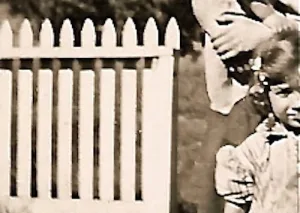 “Dwelling with ladder and wooden structure on top,” Dunbar, Queensland, between 1900 and 1951, by John Flynn, via Australian Inland Mission Collection, National Library of Australia Commons on flickr.
“Dwelling with ladder and wooden structure on top,” Dunbar, Queensland, between 1900 and 1951, by John Flynn, via Australian Inland Mission Collection, National Library of Australia Commons on flickr.
I have no explanation for the second-story (sleeping porch maybe?). . . but it’s kinda cool.

I wonder if the second story is a kind of observation platform. Dunbar isn’t too far away from the ocean (at least it looks that way on a map); or maybe whoever lived in the house wanted to do some kangaroo spotting???
I thought about an observation platform too. I thought about star gazing, but then why would it have a roof? And if it’s to spot visitors approaching, it seems bigger than it would need to be. I will have to keep looking among Australia pictures for something like it.
I’ll send the photo to my Australian daughter-in-law to see if she has any ideas.
I received the following from Australian relatives: “My guess is that the upstairs is a sitting out (or up) area to take advantage of any breeze that might be detectable. Dunbar’s climate is tough- no month with a mean max temperature below 30C and in the summer quite often heavy rainfall and very high humidity. Given that the area is also cyclone prone is seems to me that only a supreme optimist would erect a such structure and expect it to withstand too much 100km per hour wind if a cyclone came along.”
Thanks so much to you and your far-flung family!!
I’m leaning toward sleeping porch — hoping that the wind didn’t blow it away and take the roof (or the sleeper) with it. (Perhaps the man who built it was new to the region and thought he’d hit on an idea the locals had never thought of.)
But I had two other guesses:
I just went back and read more closely the brief bio of John Flynn (linked to his name above). He was Superintendent of the Australian Inland Mission, and it says that he was instrumental in installing a radio station in Cloncurry and then putting batteryless (petal) radios in the surrounding homesteads and missions. I wonder if this picture was used to illustrate a platform that would improve broadcasting power or reception.
I also read more about Dunbar as a cattle station of 10,000 to 30,000 head, and it occurred to me that this could have been an observation deck for one of the men to direct incoming herds into the correct yards (branding, tailing, horse yards) — which may have been located to the left or right of the image or behind the photographer.
Catching up on many posts but this was so quirky. To my modern eye it looked like a conceptual art statement built on top of one’s parents’ house . . .
[…] in a hollowed out pumpkin, Gippsland, Victoria, 1906, by John Flynn, via National Library of Australia Commons on […]